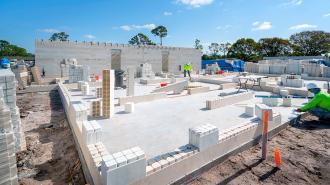A new system combining LEGO-like blocks and color-coded building plans could be the future of construction.
The challenge: The US isn’t building enough new houses, which is driving up the prices of the homes that are available, leading to a shortage of affordable housing.
The solution to this is straightforward on paper — build more affordable houses — but a combination of factors, including a recent shortage of construction workers and an increase in the cost of construction materials, is preventing the supply from keeping up with demand.
The future of construction: Instead of using traditional materials, like wood or concrete, to build new homes, Miami-based company Renco USA is constructing them from LEGO-like blocks made of recycled plastic and glass fibers, mixed with resin and stone.
These blocks are 100% recyclable, fire retardant, and 23 times stronger than concrete, according to Renco. During construction, color-coded building plans tell workers where to stack blocks of different shapes and sizes. They then use a glue gun filled with industrial adhesive and a mallet to permanently connect the blocks.
“We now have the chance of a lifetime to revolutionize the future of construction.”
Tom Murphy Jr.
The Renco system was developed in Turkey, where it has been used for more than 100 building projects in the past decade. After finding out about it, construction veteran Tom Murphy Jr. went through the process of getting it certified for use in the US.
“Renco addresses America’s labor shortage because workers don’t need specialized training — instead, nearly anyone can build the color-coded, interlocking system with easy-to-follow plans, all in a shorter time than typical construction,” said Murphy, co-founder of Renco USA. “These advantages also mean builders can create more housing units, more affordably.”
What’s new? Renco USA cut the ribbon on its first project, a 96-unit apartment complex in Palm Springs, Florida, in November 2023, and as of December, its four buildings were already 90% occupied.
It took 11 unskilled workers just 8 weeks on average to construct each of the complex’s three-story buildings, and Renco says construction was 20% faster and 20% cheaper than it would have been using concrete.
“No heavy equipment was required,” a company spokesperson told Global Construction Review (GCR). “We used no exterior scaffolding, no cutting, burning, welding, or grinding was necessary.”
Looking ahead: Renco has completed construction on a manufacturing factory in Jupiter, Florida, which Murphy told Fast Company has the capacity to produce enough blocks for 5,000 apartment units annually. He also said the company is talking with developers across the nation about using Renco for a range of projects.
“We now have the chance of a lifetime to revolutionize the future of construction,” Murphy told GCR. “This means creating homes that are not only sustainable and resilient, but built to endure for generations yet to come.”
We’d love to hear from you! If you have a comment about this article or if you have a tip for a future Freethink story, please email us at tips@freethink.com.
